The Relationship between the Color Landscape Characteristics of Autumn Plant Communities and Public Aesthetics in Urban Parks in Changsha, China
Abstract
:1. Introduction
2. Materials and Methods
2.1. Study Area and Sample Plot Selection
2.2. Photography
2.3. Scenic Beauty Estimation
2.4. Color Quantization Based on the HSB Model
2.5. Selection of Color Element Indicators
2.6. Data Processing and Analysis
2.6.1. Analysis of the Relationship between the Structural Characteristics of Plant Communities and the SBE Values
2.6.2. Construction of Color Landscape Characteristic Index and Comprehensive Model of Autumn Plant Community in Urban Parks
2.6.3. Correlation Analysis between Color Landscape Characteristic Indicators and SBE Grades of the Plant Community
2.6.4. Classification of Color Composition Types of Plots with a High SBE Level (Grade I and II)
3. Results
3.1. Landscape Beauty Evaluation
3.2. Relationship between the Structural Characteristics of Plant Communities and the SBE Values
3.3. Construction of the Color Landscape Characteristic Index and Comprehensive Model of Autumn Plant Community in Urban Parks
3.4. Correlation between the Color Landscape Characteristic Index and SBE Grade of the Autumn Plant Community
3.4.1. The Effect of Principal Components on SBE Grade
3.4.2. Correlation between Color Element Indicators and SBE Grades
3.5. Classification and Color Composition Characteristics of Plots with High SBE Level (Grade I and II)
3.6. Quantitative Color Analysis of High-Quality Plant Communities
4. Discussion
5. Conclusions
Supplementary Materials
Author Contributions
Funding
Institutional Review Board Statement
Informed Consent Statement
Data Availability Statement
Conflicts of Interest
References
- Bell, S. Elements of Visual Design in the Landscape; E&FN Spon Press: London, UK, 2004. [Google Scholar]
- Grose, M.J. Plant colour as a visual aspect of biological conservation. Biol. Conserv. 2012, 153, 159–163. [Google Scholar] [CrossRef]
- Daniel, T.C. Whither scenic beauty? Visual landscape quality assessment in the 21st century. Landsc. Urban Plan. 2001, 54, 267–281. [Google Scholar] [CrossRef]
- Tong, Z.; Ma, Y. Elements of plant color matching in intelligent landscape design. In Proceedings of the 2020 International Conference on Intelligent Design (ICID), Xi’an, China, 11–13 December 2020; pp. 214–218. [Google Scholar]
- Harris, V.; Kendal, D.; Hahs, A.K.; Threlfall, C.G. Green space context and vegetation complexity shape people’s preferences for urban public parks and residential gardens. Landsc. Res. 2018, 43, 150–162. [Google Scholar] [CrossRef]
- Ahas, R.; Aasa, A.; Silm, S.; Roosaare, J. Seasonal indicators and seasons of Estonian landscapes. Landsc. Res. 2005, 30, 173–191. [Google Scholar] [CrossRef]
- Kaufman, A.; Lohr, V. Does plant color affect emotional and physiological responses to landscapes? In Proceedings of the XXVI International Horticultural Congress: Expanding Roles for Horticulture in Improving Human Well-Being and Life Quality, Toronto, ON, Canada, 11–17 August 2002; Volume 639, pp. 229–233. [Google Scholar]
- Osman, U.; Haldun, M. Visual landscape quality in landscape planning: Examples of Kars and Ardahan cities in Turkey. Afr. J. Agric. Res. 2011, 6, 1627–1638. [Google Scholar]
- Zhang, Y.K.; Wang, X.R.; Yang, T.; Zhou, L.; Bai, C. Change Characteristics of New Leaf Color Attributes of Common Garden Plants in Guiyang City in Spring. J. Northwest For. Univ. 2019, 34, 208–213. [Google Scholar]
- Mu, Y.; Lin, W.; Diao, X.; Zhang, Z.; Wang, J.; Lu, Z.; Guo, W.; Wang, Y.; Hu, C.; Zhao, C. Implementation of the visual aesthetic quality of slope forest autumn color change into the configuration of tree species. Sci. Rep. 2022, 12, 1034. [Google Scholar] [CrossRef]
- Zhang, X.J.; Chen, J.; Li, Q.Y.; Liu, J.C.; Tao, J.P. Color quantification and evaluation of landscape aesthetic quality for autumn landscape forest based on visual characteristics in subalpine region of western Sichuan, China. Chin. J. Appl. Ecol. 2020, 31, 45–54. [Google Scholar]
- Wang, X.G.; Wang, Z.R.; He, X.Y.; Lian, F.L.; Hong, Z.; Wang, J.F.; Du, Y.X.; Tang, L. The beauty degree of forest facies and its optimal color composition pattern in the southwest Zhejiang Province in autumn. J. Nanjing For. Univ. 2019, 43, 118–126. [Google Scholar]
- Ma, B.Q.; Xu, C.Y.; Cui, Y. Effects of Color Composition in Badaling Forests on Autumn Landscape Quality. J. Northwest For. Univ. 2018, 33, 258–264. [Google Scholar]
- Zheng, Y.; Zhang, W.Q.; Wu, Q.N.; Chen, Z.R.; Wang, Y.C.; Ding, G.C.; Chen, S.P.; Fu, W.C.; Zhu, Z.P.; Huang, S.P.; et al. The Color Quantization of the Fall Scenic Forest in Jinsi Canyon National Forest Park in Shaanxi Province. J. Northwest For. Univ. 2016, 31, 275–280. [Google Scholar]
- Ye, X.Q.; Wang, L.; Guan, H.W.; Zhou, S.; Yu, R.; Shen, X.D. Landscape Construction and Analysis of Autumn Color Plants in Northwest China—A Case Study of the Autumn Garden in Yinchuan Botanical Garden. Chin. Landsc. Archit. 2018, 1, 94–97. [Google Scholar]
- Li, C.L.; Shen, S.G.; Ding, L. Evaluation of the winter landscape of the plant community of urban park green spaces based on the scenic beauty esitimation method in Yangzhou, China. PLoS ONE 2020, 15, e0239849. [Google Scholar] [CrossRef]
- Wang, Z.; Li, M.Y. Methods of Color Plan of Landscape Forest at All Seasons—A Case Study of Purple Mountain. For. Resour. Manag. 2017, B12, 70–76. [Google Scholar]
- Shi, K.; Zuo, G.; Hu, H. Evaluation on aesthetic quality of plant color landscape in urban parks of Harbin based on public aesthetic. J. Nanjing For. Univ. 2022, 46, 233–240. [Google Scholar]
- Yang, L.; Wang, X.R.; Li, Y.Q.; Yang, J.; Han, S. Quantitative Analysis of Plant Community Landscape Color in Guanshan Lake Park of Guiyang City. Engl. J. Southwest For. Univ. 2021, 41, 152–161. [Google Scholar]
- Jang, H.S.; Kim, J.; Kim, K.S.; Pak, C.H. Human brain activity and emotional responses to plant color stimuli. Color Res. Appl. 2014, 39, 307–316. [Google Scholar] [CrossRef]
- Xing, X.; Hao, P.; Dong, L. Color characteristics of Beijing’s regional woody vegetation based on Natural Color System. Color Res. Appl. 2019, 44, 595–612. [Google Scholar] [CrossRef]
- Lev-Yadun, S.; Holopainen, J.K. Why red-dominated autumn leaves in America and yellow-dominated autumn leaves in Northern Europe? New Phytol. 2009, 183, 506–512. [Google Scholar] [CrossRef]
- Mao, B.; Gong, L.; Xu, C. Evaluating the scenic beauty of individual trees: A case study using a nonlinear model for a pinus tabulaeformis scenic forest in Beijing, China. Forests 2015, 6, 1933–1948. [Google Scholar] [CrossRef]
- Wang, Z.; Li, M.; Zhang, X.; Song, L. Modeling the scenic beauty of autumnal tree color at the landscape scale: A case study of Purple Mountain, Nanjing, China. Urban For. Urban Green. 2020, 47, 126526. [Google Scholar] [CrossRef]
- Archetti, M.; Richardson, A.D.; O’Keefe, J.; Delpierre, N. Predicting climate change impacts on the amount and duration of autumn colors in a New England forest. PLoS ONE 2013, 8, e57373. [Google Scholar] [CrossRef] [PubMed]
- Zhang, Z.; Qie, G.; Wang, C.; Jiang, S.; Li, X.; Li, M. Relationship between forest color characteristics and scenic beauty: Case study analyzing pictures of mountainous forests at sloped positions in Jiuzhai Valley, China. Forests 2017, 8, 63. [Google Scholar] [CrossRef]
- Shen, S.; Yao, Y.; Li, C. Quantitative study on landscape colors of plant communities in urban parks based on natural color system and M-S theory in Nanjing, China. Color Res. Appl. 2022, 47, 152–163. [Google Scholar] [CrossRef]
- Sha, X.M. Effects of Seasonal Changes of Garden Plants on the Construction of Spatial Landscape Pattern. Mol. Plant Breed. 2018, 16, 3078–3084. [Google Scholar]
- Zhang, Y. Analysis on color configuration of plants in landscape design. In Applied Mechanics and Materials; Trans Tech Publications: Zurich, Switzerland, 2013; pp. 2122–2125. [Google Scholar]
- Ou, L.C.; Yuan, Y.; Sato, T.; Lee, W.Y.; Szabó, F.; Sueeprasan, S.; Huertas, R. Universal models of colour emotion and colour harmony. Color Res. Appl. 2018, 43, 736–748. [Google Scholar] [CrossRef]
- Szabo, F.; Bodrogi, P.; Schanda, J. Experimental Modeling of Colour Harmony. Color Res. Appl. 2010, 35, 34–49. [Google Scholar] [CrossRef]
- O’Connor, Z. Colour harmony revisited. Color Res. Appl. 2010, 35, 267–273. [Google Scholar] [CrossRef]
- Nasar, J.L. Urban design aesthetics: The evaluative qualities of building exteriors. Environ. Behav. 1994, 26, 377–401. [Google Scholar] [CrossRef]
- Zhang, Z.; Xu, C.; Gong, L.; Cai, B.J.; Li, C.C.; Huang, G.Y.; Li, B. Assessment on Structural Quality of Landscapes in Green Space of Beijing Suburban Parks by SBE Method. Sci. Silvae Sin. 2011, 47, 53–60. [Google Scholar]
- Yang, S.; Gu, X.; Chen, K.; Dong, F.L.; Zhang, L.G.; Jia, X. The Status Quo and Trend of Applying SBE in Landscape Evaluation. J. West China For. Sci. 2019, 48, 148–156. [Google Scholar]
- Cheng, Y.; Tan, M. The quantitative research of landscape color. A study of Ming Dynasty City Wall in Nanjing. Color Res. Appl. 2018, 43, 436–448. [Google Scholar]
- Li, W.; Xing, Z.; Suolang, Z.; Fang, J. Configuration Mode of Ornamental Plants in Norbulingka of Tibet and Application of Landscape Color. Curr. Urban Stud. 2018, 6, 278–291. [Google Scholar] [CrossRef]
- Liu, Y.; Cai, J.G.; Shu, M.Y. A quantitative study on plant color in the autumn plant community of West Lake, Hangzhou. J. Anhui Agric. Univ. 2022, 49, 56–61. [Google Scholar]
- Frank, S.; Fürst, C.; Koschke, L.; Witt, A.; Makeschin, F. Assessment of landscape aesthetics—Validation of a landscape metrics-based assessment by visual estimation of the scenic beauty. Ecol. Indic. 2013, 32, 222–231. [Google Scholar] [CrossRef]
- Daniel, T.C.; Boster, R.S. Measuring Landscape Esthetics: The Scenic Beauty Estimation Method; US Department of Agriculture: Washington, DC, USA, 1976. [Google Scholar]
- Li, M.Y.; Huang, X.L.; Yuan, F.; Xu, L.P. Packaging Color Design Based on Munsell Color Harmony Theory. Packag. Eng. 2017, 38, 219–223. [Google Scholar]
- Cochrane, S. The Munsell Color System: A scientific compromise from the world of art. Stud. Hist. Philos. Sci. Part A 2014, 47, 26–41. [Google Scholar] [CrossRef]
- Lei, Z.; Fuzong, L.; Bo, Z. A CBIR method based on color-spatial feature. In Proceedings of the IEEE Region 10 Conference TENCON 99’Multimedia Technology for Asia-Pacific Information Infrastructure’ (Cat No 99CH37030), Cheju Island, Republic of Korea, 15–17 September 1999; pp. 166–169. [Google Scholar]
- Smith, J.R. Integrated Spatial and Feature Image Systems: Retrieval, Analysis and Compression; Columbia University: New York, NY, USA, 1997. [Google Scholar]
- Tian, Y.M.; Lin, G.S. Retrieval technique of color image based on color features. J. Xidian Univ. 2002, 29, 56–61. [Google Scholar]
- Gao, Y.; Zhang, T.; Zhang, W.; Meng, H.; Zhang, Z. Research on visual behavior characteristics and cognitive evaluation of different types of forest landscape spaces. Urban For. Urban Green. 2020, 54, 126788. [Google Scholar] [CrossRef]
- Chen, J.; Liu, B.; Rui, L.I.; Liu, Y.; Yonghua, L.I.; University, H.A. Research on plant configuration based on quantitative analysis of plant community color composition. J. Henan Agric. Univ. 2019, 53, 550–556. [Google Scholar]
- Yang, Y.; Tang, X.L.; Liu, L.; Jia, Y.Y.; Luo, H. Plantscape Quality Evalution Based on Principal Components Method and SBE Method-A Case Study of Six Universities Campuses in Nanjing. J. Northwest For. Univ. 2020, 35, 256–264. [Google Scholar]
- Li, Z.; Chen, F.; Han, X.; Zhan, K.Y. The Principal Component Quantitative Analysis of Landscape Attraction Based on the EEG Technology—Taking Xuanwu Lake Park of Nanjing as the Example. Chin. Landsc. Archit. 2021, 37, 60–65. [Google Scholar]
- Schirpke, U.; Tasser, E.; Tappeiner, U. Predicting scenic beauty of mountain regions. Landsc. Urban Plan. 2013, 111, 1–12. [Google Scholar] [CrossRef]
- An, J.; Liu, N.N.; Yang, R.H.; Zhao, J.H. Scenic Beauty Evaluation for Summer-Plant Landscape of Huaxi Wetland Park in Guiyang City. Ecol. Econ. 2014, 30, 194–199. [Google Scholar]
- Nishiyama, M.; Okabe, T.; Sato, I.; Sato, Y. Aesthetic quality classification of photographs based on color harmony. In Proceedings of the CVPR 2011, Colorado Springs, CO, USA, 20–25 June 2011; pp. 33–40. [Google Scholar]
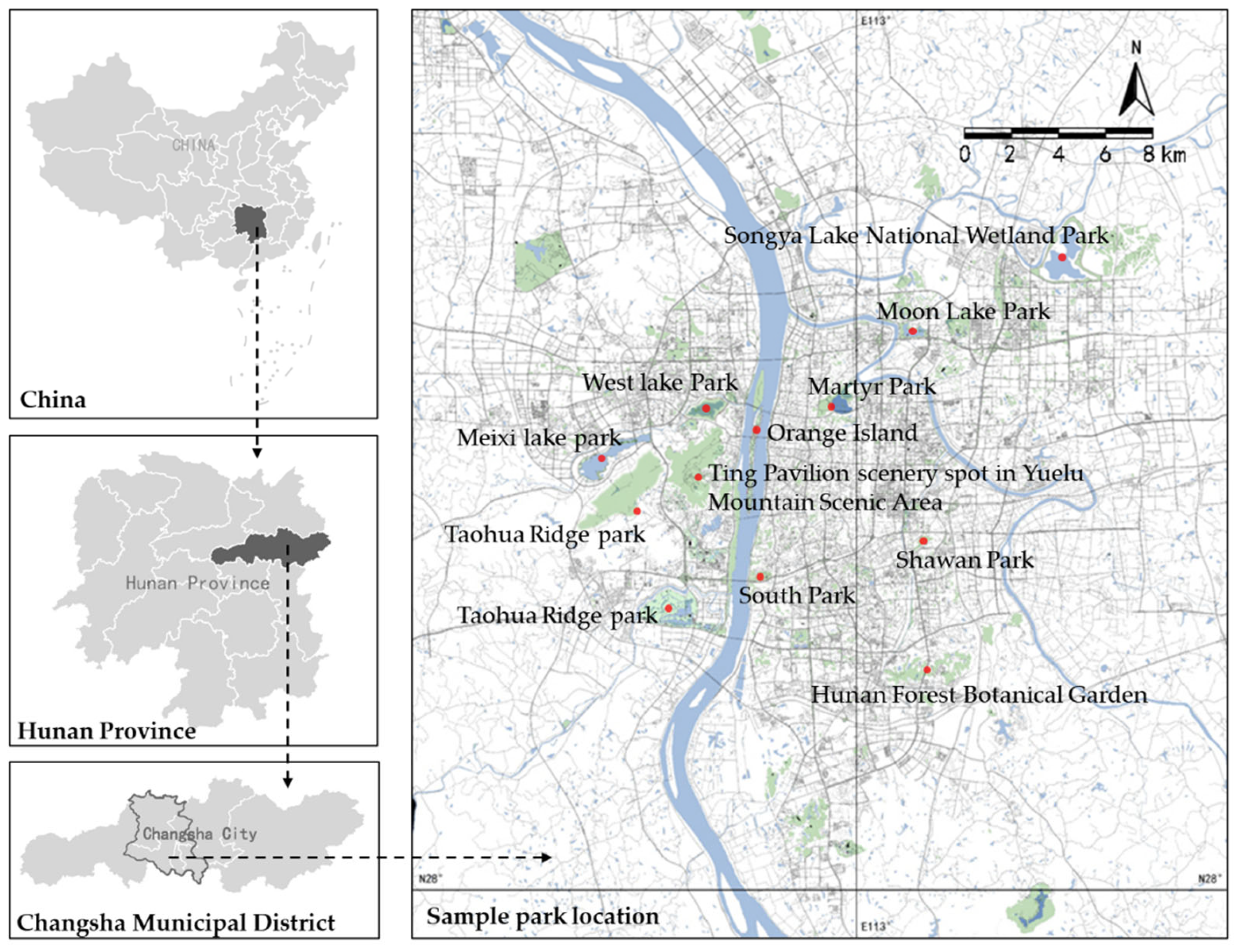
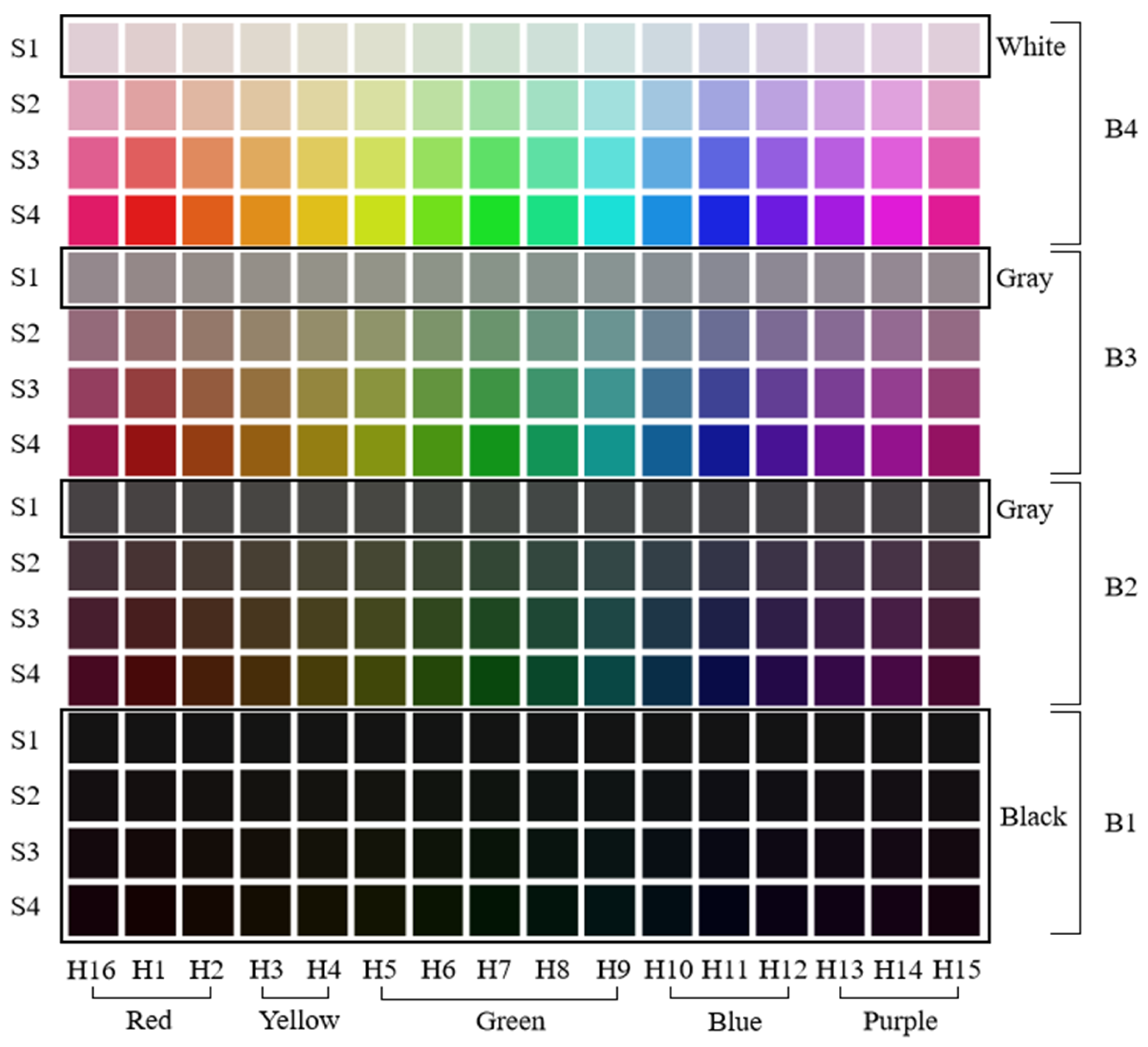
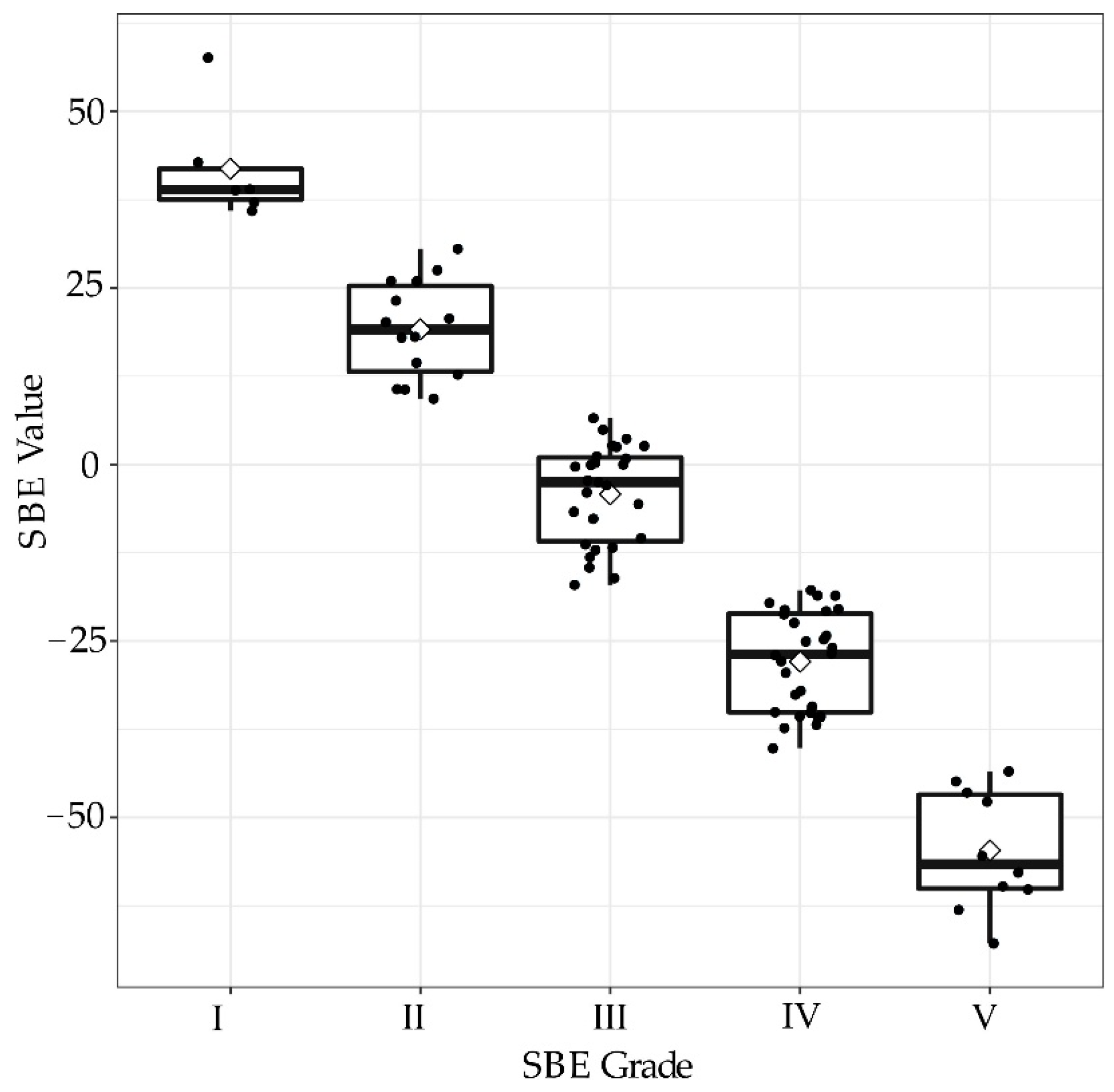
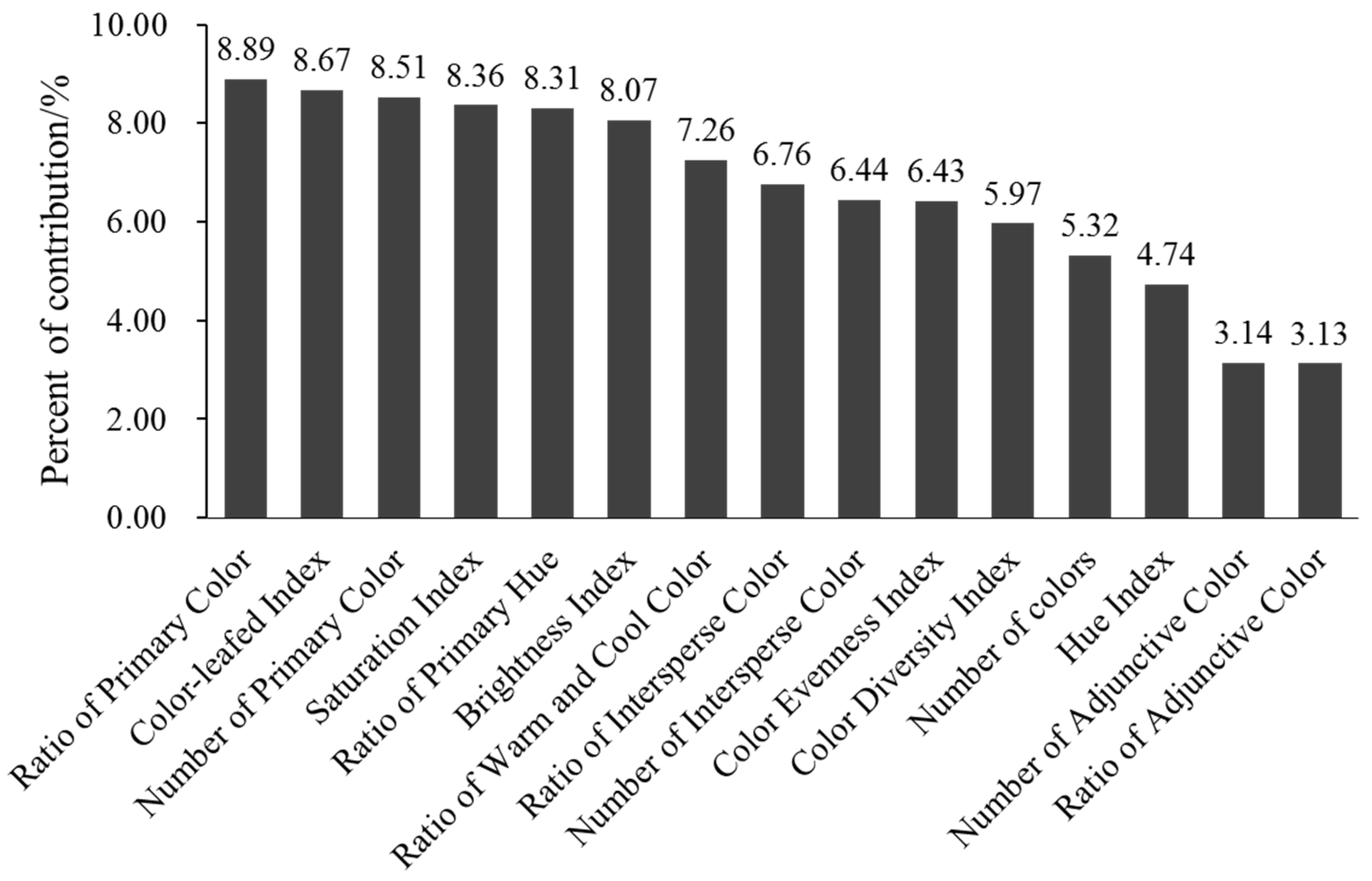
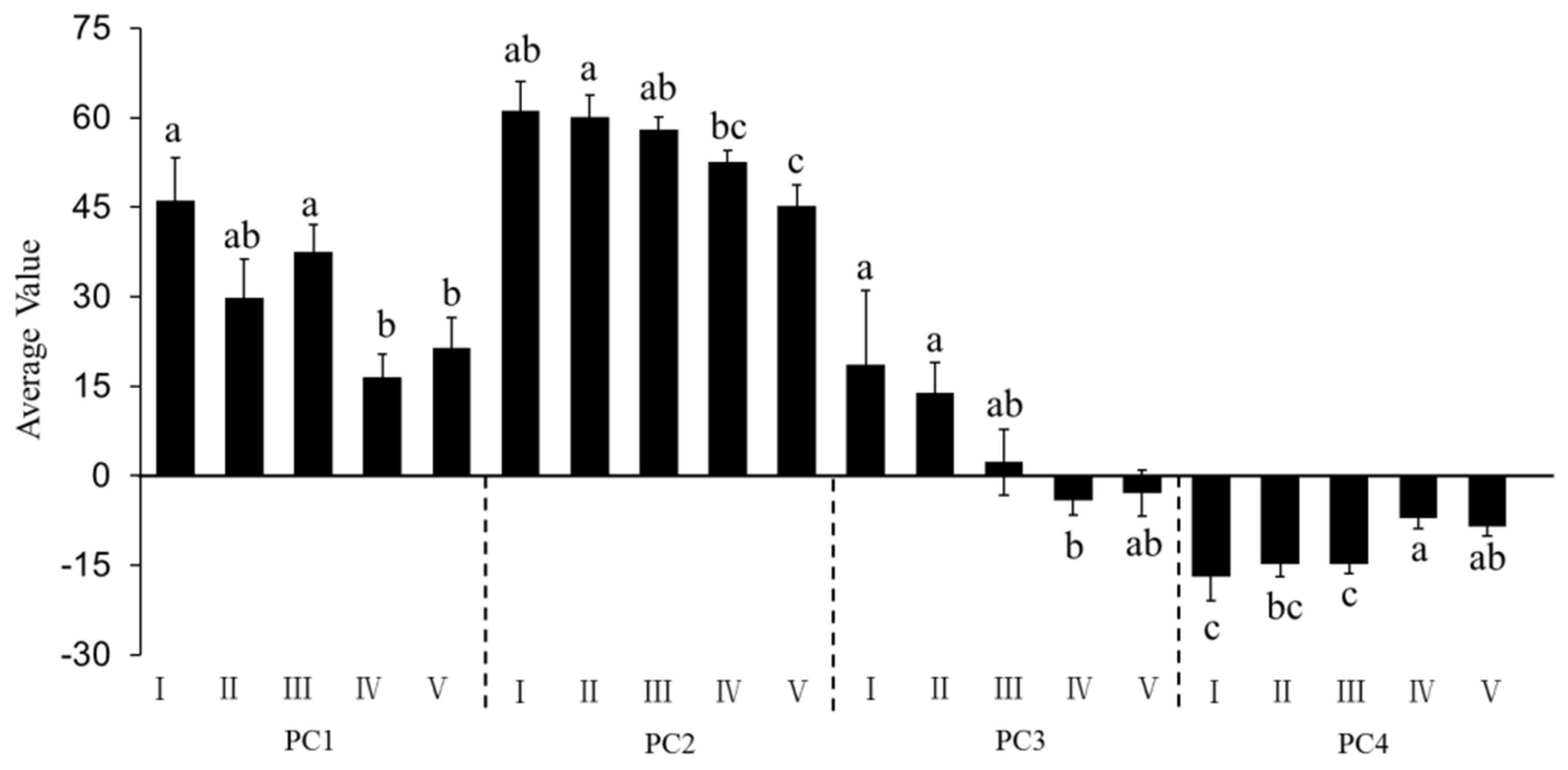
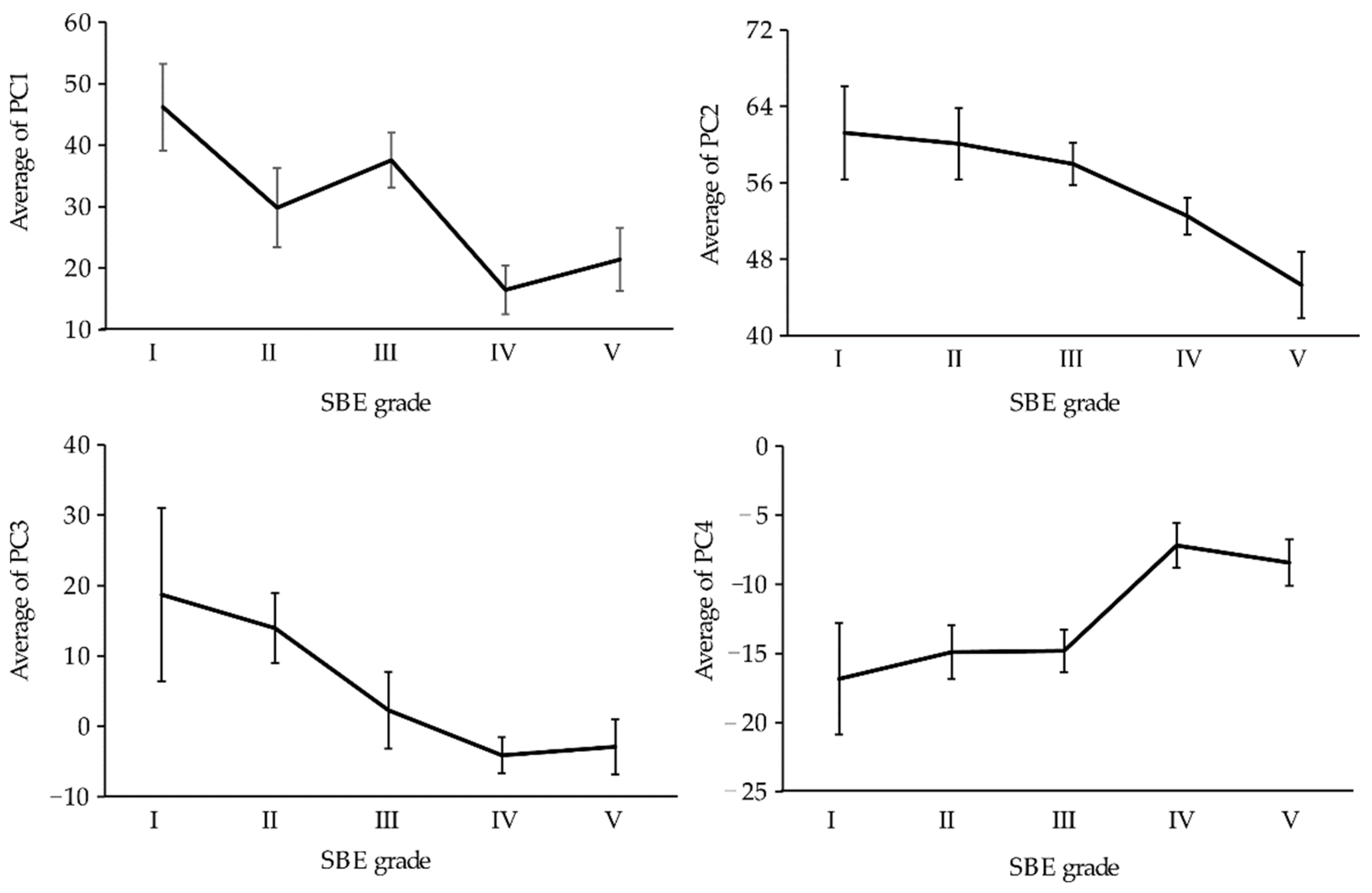
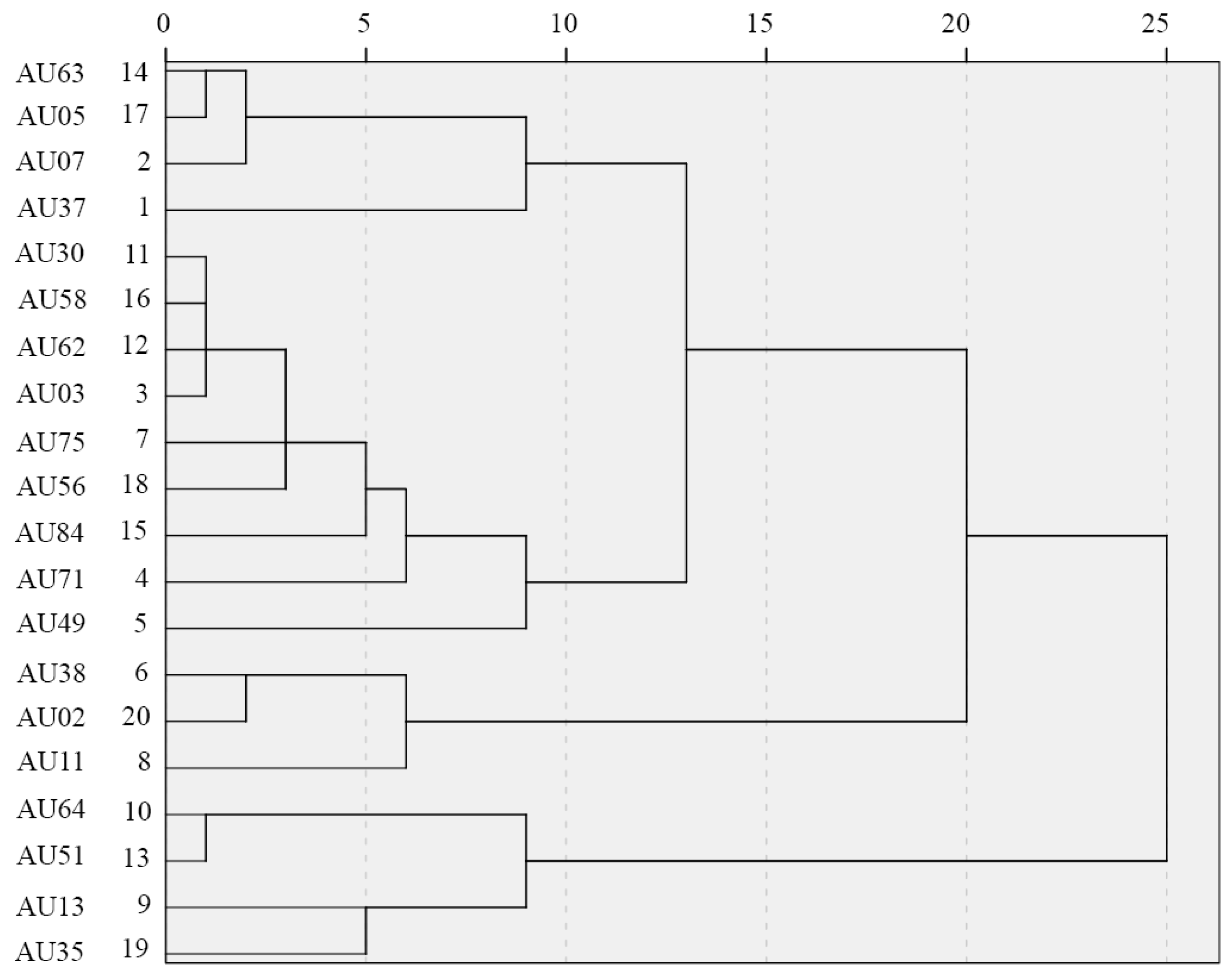
| Serial Number | Park Name | Park Location | Park Size (Hectares) | Number of Plant Communities Photographed | Number of plant Communities Selected |
|---|---|---|---|---|---|
| 1 | Orange Island | 112°96′87.43″ N, 28°19′29.29″ E | 91.6 | 62 | 6 |
| 2 | Aiwan Ting Pavilion scenery spot in Yuelu Mountain Scenic Area | 112°94′40.7″ N, 28°18′67.42″ E | 0.6 | 55 | 7 |
| 3 | West Lake Park | 112°94′11.17″ N, 28°20′95.62″ E | 148.1 | 123 | 23 |
| 4 | Meixi Lake Park | 112.90′90.83″ N, 28.19′89.34″ E | 24.5 | 52 | 7 |
| 5 | Taohua Ridge Park | 112.90′66.28″ N, 28.18′16.04″ E | 290.7 | 33 | 1 |
| 6 | Yanghu Wetland Park | 112.93′41.81″ N, 28.13′24.15″ E | 485.0 | 82 | 10 |
| 7 | Martyr Park | 113.00′54.41″ N, 28.21′77.85″ E | 153.3 | 127 | 17 |
| 8 | Moon Lake Park | 113.03′77.86″ N, 28.24′43.63″ E | 66.9 | 30 | 3 |
| 9 | South Park | 112.97′21.74″ N, 28.14′67.3″ E | 36.5 | 34 | 1 |
| 10 | Shawan Park | 113.04′56.6″ N, 28.16′12.36″ E | 28.9 | 24 | 1 |
| 11 | Hunan Forest Botanical Garden | 113.03′84.55″ N, 28.10′95.94″ E | 140.0 | 30 | 4 |
| 12 | Songya Lake National Wetland Park | 113.11′34.73″ N, 28.27′28.22″ E | 365.0 | 69 | 5 |
| Basic Information | Category | Number | Percent (%) | Basic Information | Category | Number | Percent (%) |
|---|---|---|---|---|---|---|---|
| Ability to accurately identify colors | Yes | 297 | 100 | Education | Undergraduate | 160 | 53.9 |
| No | 0 | 0 | Master’s degree | 82 | 27.6 | ||
| Gender | Men | 132 | 44.4 | PhD candidate | 19 | 6.4 | |
| Women | 165 | 55.6 | Annual park recreation times | 0 | 5 | 1.7 | |
| Age | Under 18 years old | 4 | 1.3 | 1~3 | 85 | 28.6 | |
| 18~25 years old | 150 | 50.5 | 4~10 | 101 | 34.0 | ||
| 26~30 years old | 45 | 15.2 | 11~20 | 61 | 20.5 | ||
| 31~40 years old | 76 | 25.6 | 21~100 | 39 | 13.1 | ||
| 41~50 years old | 12 | 4.1 | 101~200 | 0 | 0 | ||
| 51~60 years old | 6 | 2.0 | 201 or more | 6 | 2.0 | ||
| 61 years old or older | 4 | 1.3 | Professional/occupation | Landscape architecture and related | 137 | 46.1 | |
| Education | Primary education | 18 | 6.1 | Others | 160 | 53.9 | |
| Junior education | 18 | 6.1 |
| Element | Indictor | Abbreviation | Formula |
|---|---|---|---|
| Color properties | Hue Index | IH | ; is the i’th hue value, and is the proportion of pixels occupied by the i’th hue. I = 1, 2,…, 16. |
| Saturation Index | IS | ; is the i’th saturation value, and is the pixel proportion of the i’th saturation, i = 1,2,…, 4. | |
| Brightness Index | IB | ; is the i’th brightness value, and is the proportion of pixels occupied by the i’th brightness, i = 1, 2,…, 4. | |
| Color Composition Relation | Number of Color | NC | NC = SUM (HaSbBc), HaSbBcPi ≥ 1%; the number of colors whose pixel ratio is ≥1% among 147 colors. Pi is the pixel proportion of the ith color. |
| Color Diversity Index | HC | is the pixel proportion of the i’th color, and S is the number of colors, . | |
| Color Evenness Index | EC | EC = HC/lnS; HC is color diversity index, and S is color number, . | |
| Number of Primary Color | NP | In red, yellow, green, blue and purple, the number of colors with 40~100% pixels. | |
| Ratio of Primary Color | RP | In red, yellow, green, blue and purple, the proportion of pixels in the color system is 40~100%. | |
| Number of Adjunctive Color | NA | In red, yellow, green, blue and purple, the number of colors with 10~40% pixels. | |
| Ratio of Adjunctive Color | RA | In red, yellow, green, blue and purple, the proportion of pixels in the color system is 10~40%. | |
| Number of Intersperse Color | NI | In red, yellow, green, blue and purple, the number of colors <10% pixels. | |
| Ratio of Intersperse Color | RI | In red, yellow, green, blue and purple, the proportion of pixels in the color system is <10% pixels. | |
| Ratio of Primary Hue | RPH | In addition to black, white and gray, the pixel proportion of the largest hue. | |
| Color-Leafed Index | RC | , , and are the pixel proportions of hue H1, H2, H3, H4 and H16, respectively. | |
| Ratio of Warm and Cool Color | RWC | is the warm-tone pixel, is the cold-tone pixel. |
| Serial Number | Color Element Indicator | Component | |||
|---|---|---|---|---|---|
| 1 | 2 | 3 | 4 | ||
| 1 | RP (Ratio of Primary Color) | 0.413 | 0.074 | 0.000 | −0.128 |
| 2 | NP (Number of Primary Color) | 0.388 | 0.058 | −0.006 | −0.168 |
| 3 | RPH (Ratio of Primary Hue) | 0.358 | 0.005 | 0.037 | −0.110 |
| 4 | RA (Ratio of Adjunctive Color) | −0.353 | 0.190 | −0.030 | −0.160 |
| 5 | NA (Number of Adjunctive Color) | −0.339 | 0.202 | −0.081 | −0.154 |
| 6 | EC (Color Evenness Index) | −0.146 | 0.494 | −0.034 | −0.020 |
| 7 | IB (Brightness Index) | 0.034 | 0.487 | −0.009 | 0.051 |
| 8 | HC (Color Diversity Index) | −0.186 | 0.470 | −0.137 | 0.118 |
| 9 | IS (Saturation Index) | 0.108 | 0.393 | 0.145 | −0.122 |
| 10 | NC (Number of colors) | −0.204 | 0.346 | −0.226 | 0.271 |
| 11 | RWC (Ratio of Warm and Cool Color) | 0.052 | −0.043 | 0.559 | −0.159 |
| 12 | RC (Colored Index) | 0.057 | 0.249 | 0.533 | −0.087 |
| 13 | IH (Hue Index) | −0.010 | 0.225 | −0.501 | −0.039 |
| 14 | RI (Ratio of Intersperse Color) | −0.023 | 0.034 | −0.131 | 0.750 |
| 15 | NI (Number of Intersperse Color) | −0.084 | 0.000 | −0.030 | 0.746 |
| Color Element Indicator | Mean ± SE | ||||
|---|---|---|---|---|---|
| I | II | III | IV | V | |
| RPH (Ratio of Primary Hue) | 51.16 ± 9.30 a | 45.59 ± 4.20 a | 49.56 ± 3.36 a | 33.15 ± 2.38 b | 34.59 ± 4.03 b |
| RWC (Ratio of Warm and Cool Color) | 18.67 ± 6.97 a | 7.32 ± 1.83 b | 8.78 ± 2.37 b | 4.01 ± 1.19 b | 4.00 ± 1.49 b |
| RC (Color-leafed Index) | 52.97 ± 10.90 a | 50.50 ± 6.54 a | 38.75 ± 5.12 ab | 28.80 ± 2.44 b | 25.02 ± 4.55 b |
| NP (Number of Primary Color) | 1.00 ± 0.00 a | 0.71 ± 0.13 ab | 0.81 ± 0.08 a | 0.54 ± 0.11 b | 0.60 ± 0.16 ab |
| RP (Ratio of Primary Color) | 56.83 ± 7.06 a | 40.46 ± 7.68 ab | 49.74 ± 4.99 a | 24.68 ± 4.98 b | 26.98 ± 7.38 b |
| NA (Number of Adjunctive Color) | 0.33 ± 0.21 a | 1.00 ± 0.26 a | 0.63 ± 0.17 a | 1.00 ± 0.18 a | 0.70 ± 0.15 a |
| RA (Ratio of Adjunctive Color) | 5.29 ± 3.55 a | 22.79 ± 5.96 ab | 13.77 ± 3.45 ab | 22.62 ± 4.21 b | 12.84 ± 3.52 ab |
| NI (Number of Intersperse Color) | 1.83 ± 0.31 a | 1.86 ± 0.33 a | 1.59 ± 0.14 a | 2.11 ± 0.21 a | 1.60 ± 0.27 a |
| RI (Ratio of Intersperse Color) | 6.85 ± 2.18 a | 6.10 ± 1.11 a | 6.04 ± 0.82 a | 7.74 ± 0.98 a | 4.59 ± 0.98 a |
| NC (Number of colors) | 7.17 ± 0.70 b | 7.79 ± 0.69 b | 8.15 ± 0.46 b | 9.71 ± 0.44 a | 8.00 ± 0.71 a |
| HC (Color Diversity Index) | 1.26 ± 0.14 ab | 1.41 ± 0.12 ab | 1.32 ± 0.07 b | 1.53 ± 0.08 a | 1.29 ± 0.11 ab |
| EC (Color Evenness Index) | 0.64 ± 0.04 a | 0.69 ± 0.03 a | 0.63 ± 0.02 a | 0.67 ± 0.02 a | 0.62 ± 0.03 a |
| IH (Hue Index) | 46.23 ± 6.79 ab | 38.25 ± 3.39 b | 51.13 ± 4.36 a | 44.46 ± 2.22 ab | 39.51 ± 4.07 ab |
| IS (Saturation Index) | 31.74 ± 4.38 a | 29.83 ± 1.90 a | 28.69 ± 1.37 ab | 26.81 ± 1.45 ab | 23.22 ± 2.48 b |
| IB (Brightness Index) | 34.39 ± 2.67 a | 32.41 ± 2.46 a | 31.28 ± 1.45 a | 28.27 ± 1.13 ab | 25.85 ± 2.04 b |
| Plot Type and Number | Sample Photos | Typical Constitutive Color | Color Property Values | Hue Category and Proportion % | Primary Color and Proportion % | Classification of the Number of Plant Varieties | Classification of Vertical Structure Levels | SBE Value |
|---|---|---|---|---|---|---|---|---|
| T1-AU37 |  |  | H:14° S:31% B:16% | H1 21.96 | Red 40.48 | NV1 | PL1 | 57.60 |
 | H:23° S:62% B:32% | H2 12.15 | ||||||
 | H:26° S:54% B:41% | H3 6.41 | ||||||
 | H:23° S:47% B:58% | H2 6.37 | ||||||
 | H:29° S:37% B:69% | H3 4.86 | ||||||
| T1-AU07 |  |  | H:39° S:63% B:31% | H3 27.43 | Yellow 40.25% | NV1 | PL2 | 42.81 |
 | H:50° S:49% B:63% | H4 7.03 | ||||||
 | H:30° S:57% B:58% | H3 5.79 | ||||||
 | H:65° S:61% B:51% | H5 3.17 | ||||||
| T1-AU03 | 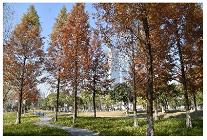 |  | H:37° S:45% B:30% | H3 48.88 | Yellow 57.38 | NV1 | PL1 | 38.99 |
 | H:24° S:46% B:57% | H2 9.32 | ||||||
 | H:47° S:38% B:64% | H4 8.50 | ||||||
 | H:67° S:49% B:51% | H5 3.18 | ||||||
| T2-AU38 | 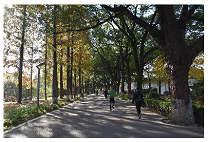 |  | H:60° S:17% B:23% | H5 70.25 | Green 73.84 | NV2 | PL2 | 35.92 |
 | H:49° S:38% B:64% | H4 3.82 | ||||||
 | H:39° S:38% B:53% | H3 3.73 | ||||||
 | H:78° S:32% B:52% | H5 3.59 | ||||||
| T2-AU11 | 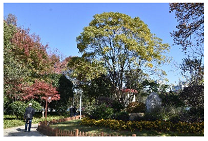 |  | H:60° S:25% B:22% | H5 44.84 | Green 50.09 | NV3 | PL3 | 27.50 |
 | H:53° S:40% B:64% | H4 5.64 | ||||||
 | H:22° S:46% B:58% | H2 3.26 | ||||||
 | H:71° S:58% B:52% | H5 2.29 | ||||||
 | H:78° S:32% B:52% | H5 1.60 | ||||||
| T2-AU02 | 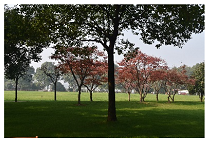 |  | H:71° S:46% B:18% | H5 68.30 | Green 78.04 | NV2 | PL2 | 9.31 |
 | H:66° S:41% B:63% | H5 5.83 | ||||||
 | H:73° S:46% B:53% | H5 3.91 | ||||||
 | H:13° S:41% B:58% | H1 3.59 | ||||||
| T3-AU13 | 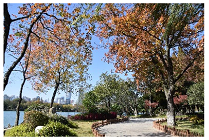 |  | H:49° S:30% B:15% | H4 19.39 | None | NV3 | PL2 | 26.00 |
 | H:43° S:53% B:37% | H3 8.29 | ||||||
 | H:41° S:44% B:70% | H3 8.16 | ||||||
 | H:23° S:51% B:60% | H2 6.32 | ||||||
 | H:24° S:60% B:32% | H2 5.34 | ||||||
 | H:81° S:43% B:27% | H6 3.21 | ||||||
 | H:76° S:36% B:52% | H5 2.31 | ||||||
| T3-AU64 | 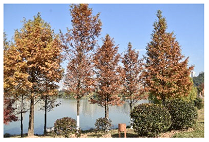 |  | H:30° S:50% B:31% | H3 27.24 | None | NV2 | PL2 | 25.96 |
 | H:34° S:45% B:74% | H3 11.05 | ||||||
 | H:25° S:53% B:59% | H2 10.81 | ||||||
 | H:71° S:25% B:51% | H5 2.67 | ||||||
| T3-AU51 | 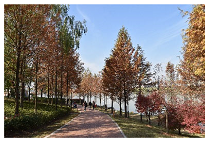 |  | H:22° S:60% B:31% | H3 19.08 | None | NV2 | PL3 | 20.16 |
 | H:38° S:52% B:37% | H2 10.55 | ||||||
 | H:21° S:45% B:58% | H2 7.51 | ||||||
 | H:33° S:40% B:69% | H3 5.82 | ||||||
 | H:79° S:42% B:26% | H5 2.25 | ||||||
 | H:73° S:25% B:51% | H5 1.61 |
Disclaimer/Publisher’s Note: The statements, opinions and data contained in all publications are solely those of the individual author(s) and contributor(s) and not of MDPI and/or the editor(s). MDPI and/or the editor(s) disclaim responsibility for any injury to people or property resulting from any ideas, methods, instructions or products referred to in the content. |
© 2023 by the authors. Licensee MDPI, Basel, Switzerland. This article is an open access article distributed under the terms and conditions of the Creative Commons Attribution (CC BY) license (https://creativecommons.org/licenses/by/4.0/).
Share and Cite
Luo, Y.; He, J.; Long, Y.; Xu, L.; Zhang, L.; Tang, Z.; Li, C.; Xiong, X. The Relationship between the Color Landscape Characteristics of Autumn Plant Communities and Public Aesthetics in Urban Parks in Changsha, China. Sustainability 2023, 15, 3119. https://doi.org/10.3390/su15043119
Luo Y, He J, Long Y, Xu L, Zhang L, Tang Z, Li C, Xiong X. The Relationship between the Color Landscape Characteristics of Autumn Plant Communities and Public Aesthetics in Urban Parks in Changsha, China. Sustainability. 2023; 15(4):3119. https://doi.org/10.3390/su15043119
Chicago/Turabian StyleLuo, Yuanyuan, Jun He, Yuelin Long, Lu Xu, Liang Zhang, Zhuoran Tang, Chun Li, and Xingyao Xiong. 2023. "The Relationship between the Color Landscape Characteristics of Autumn Plant Communities and Public Aesthetics in Urban Parks in Changsha, China" Sustainability 15, no. 4: 3119. https://doi.org/10.3390/su15043119
APA StyleLuo, Y., He, J., Long, Y., Xu, L., Zhang, L., Tang, Z., Li, C., & Xiong, X. (2023). The Relationship between the Color Landscape Characteristics of Autumn Plant Communities and Public Aesthetics in Urban Parks in Changsha, China. Sustainability, 15(4), 3119. https://doi.org/10.3390/su15043119





